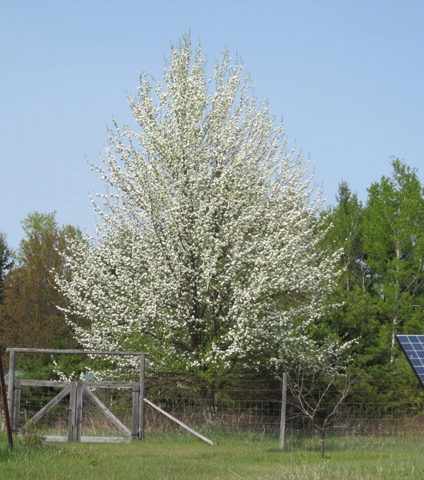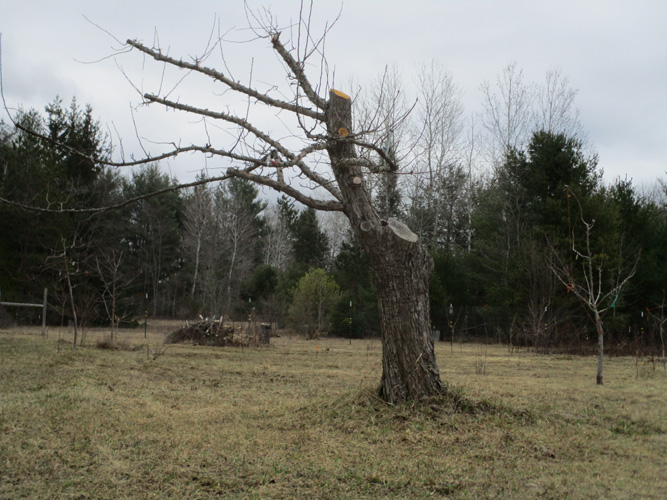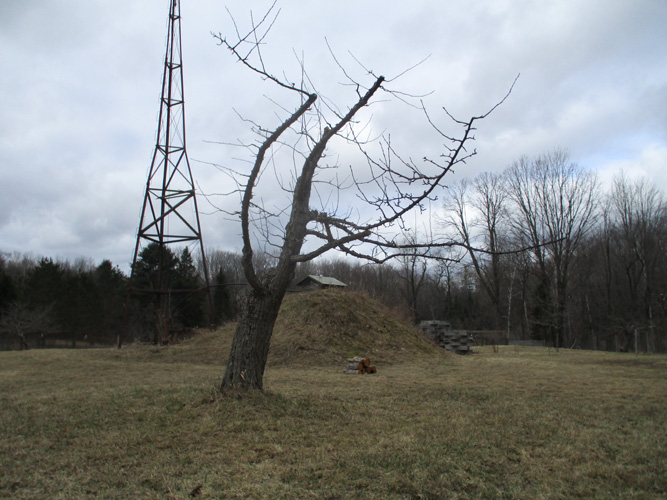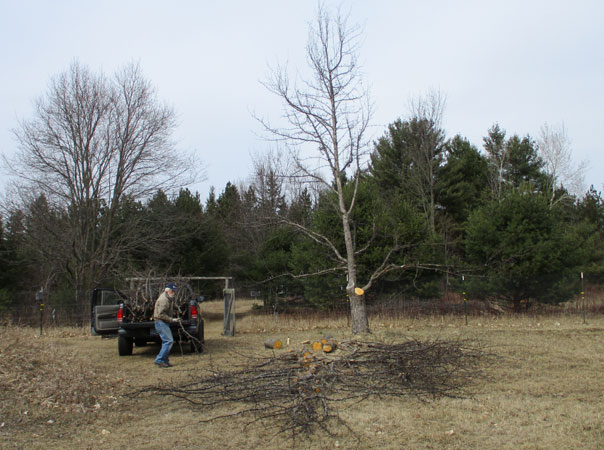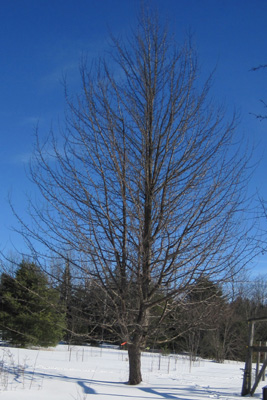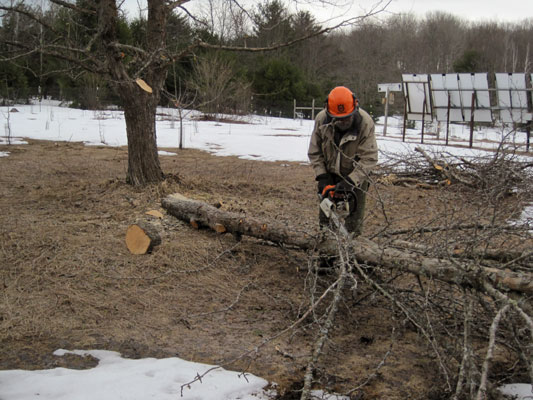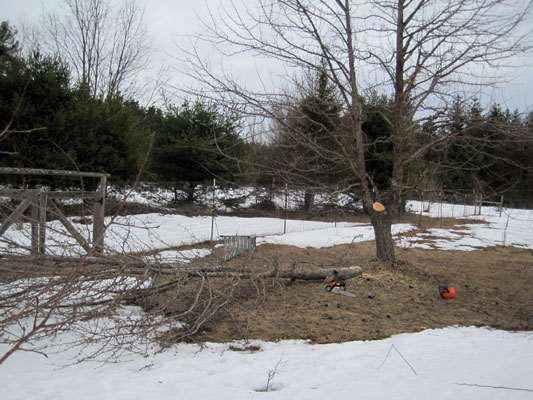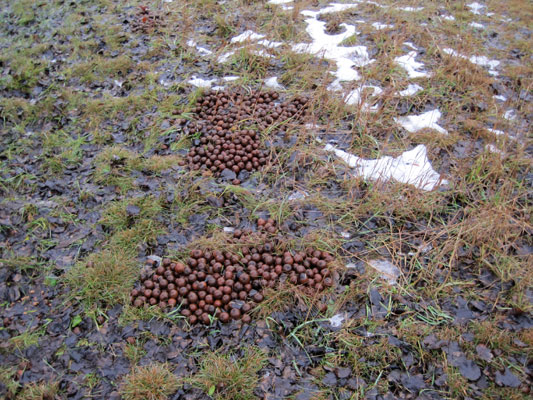|
| ||
|
Apples
Blueberries |
Chokepear
rootstock pear planted 1978
|
|
|
A Special Pear Not because of spectacular flavor (the 1 inch pears are pretty much inedible) but because of its beauty. To some (deer, squirrels, birds) the astringent small prolific fruit is the big draw. We planted it that first year on the homestead. It was a Bartlett Pear, brought with us from downstate. It died back the first or second winter. But the rootstock regrew, and grew, and thrived (until 2020), with little to no attention for most of its life. It's likely a seedling rootstock and it was gorgeous in full bloom, and a beautiful tree any time of year. 2024 Cut 2 feet off long top N limb. Other pruning moderate to open space around grafts. Pulled down some top shoots. Took off a lot of long whippy year-olds. Most looking pretty good except the limb the west L'Anse grafts are on. The L'Anses are healthy but all other growth, and the limb, has fireblight. Finally cut that limb (and sadly the grafts) off. I do have two other L'Anse grafts on a nearby limb so fingers crossed. All other grafts doing fine. Did a very little pruning on vigorous Helmer and some positioning of others. Looking good, all things considered. Actually, it's a bit of a tangled mess but there's hope. 2023 -- Regrowth April pruning I cut the top tier off and thinned out a lot of watersprouts. Also sprayed entire tree with Neem in April and early May. Thru summer sprayed many times with comfrey/spinach ferment. Cut more growth early August including ends of branches back to a graft and a lot around the grafts, removing as much as I could signs of previous year's fireblight. Growth was thick and healthy. Later there were quite a bit of black/brown leaves and some obvious fireblight but there was mostly good healthy green. Mid May I grafted a number of additional branches of last year's grafts (Helmer, Savignac and Vermont Beauty) plus a couple more L'Anse - expanding each varieties' area. The previous grafts doing fine though Savignac had some blister mites. Helmer if the most vigorous, maybe because they are on the south side. Later had to remove the new L'Anse grafts because the branch they were grafted to had FB (the grafts were healthy though). Overall I remain hopeful for this tree and its new grafts. It still has a somewhat rough looking large upper north limb but I decided not to take it off yet, having done so much other pruning. 2022 -- Drastic Measures, and Hope April 24 - Most of the top of the pear was dead or badly damaged. Though there was an amazing amount of clean shoots that grew. This tree has a strong soul and will to live. That is what will pull it through I think. The last big cut was made today, the top two thirds or so, plus a major lower limb and some branch ends. Thankfully all went well, if sad, and Steve managed the do the job without damaging any of the lower, and healthy, growing grafts. It's a guessing game whether this will help but I figure it has to be best to get as much of the fireblight infected wood out of the orchard. The lower branches certainly still show signs of fb but not as bad. Three trips with the pickup to get all those snarly gnarly branches and wood out to the pile away from the orchard out in the field. I plan to spray thoroughly with Neem oil when the weather is more favorable. And with the height down to a reachable level I will be able to pick off any blossoms should the tree decide to bloom. Though it is hard to see the tree now and not mourn its previous beautiful and stately self, I know that doesn't help the tree nor myself. So I enjoy the memory of it's former state and deliberately turn to imagining the future rebirth as a healthy "new" pear tree with human edible fruit and healthy regrowth for the many birds and squirrels who have also loved this tree. L'anse and Patten grafts survived winter and the cut-back. Lot of good new shoots. Sprayed several times with Neem before leaves, the many times with fermented comfrey/spinach tea. In May I cut off the east limb that turned out was dead, to a live short shoot at base. Not surprising it put out a lot of new growth and suckers; I cut back quite a bit through summer. A challenge to decide just how much, wanting to tame jungle and give enough air circulation, but knowing the tree is desperately (probably) trying to balance the large root system with the significantly reduced branch structure. I hug it often and hope for the best. Wanting to get edible varieties established and having all the new growth to graft to I decided to do a lot of grafting this year, getting those grafts established closer to the trunk and limbs. I got three varieties from Bob Purvis and grafted end of May -- Helmer (two on south side); Savignac (two on east side), and Vermont Beauty (three on north side). These join the three L'Anse grafts (from 2017) on west, and Patten (2020) on nw. Chokepear did surprisingly well. I cut off some more obviously fireblighted branches and shoots but it really was very healthy. In spite of everything it looked wonderful. I'm amazed by this tree.
2021 -- Second Trunk Comes Down Last year I had decided to cut off one of the three trunks on our ailing tall old seedling rootstock pear, hoping that would help. Well, I'm not sure if it triggered a tremendous attack of fireblight or if that was the result of our record long hot summer, fireblight being something we seldom see here and it loving that kind of weather. One way or another it was a rough year for the pear. But the season ended with quite a bit of green leaves so it was still alive.
I cut off all the dead and damaged wood I could reach. The only grafts to survive were the hardy and apparently disease resistant L'Anse pears. With those grafts finally getting some light they grew quite well this year. I continued to cut out damaged limbs, branches and spurs till mid season. The top of the tree is dead but there is a lot of healthy looking growth below that. Next year Steve will cut out the top, wherever he can safely reach. Our beautiful, full, large pear tree is no longer what it was. But I'll do my best to help it continue and become a revived and revised tree. Through the summer the fireblight didn't seem to get much worse, but it was apparent that more branches were badly damaged. I pruned off more infected shoots and spurs and small wood but mostly left the large cuts for dormant pruning. There was a lot of healthy green leaves and shoots, however, so I am hopeful.
2020 -- Big Pear Gets a Big Trim
April 6 - When we first moved here more than 40 years ago we planted some apple
trees and a pear. I don't recall the pear variety but it died to the
ground the first winter or two. The unknown but hardy rootstock regrew
to become a beautiful large multi-trunked tree and prolific producer of
inedible little fruits, aptly named 'chokepears'. Forward many decades
and I became much more interested in fruit, edible (to us) fruit, so as
we got into grafting I decided to graft some known pear varieties onto
this now rather old tree. Of course, we couldn't graft onto the ideal
upper branches, and even if we did it would be only for the birds and
squirrels as we wouldn't be able to reach the fruit, the tree being now
40 feet tall. Undaunted, I chose to graft on the lower but quite shaded
branches that we could reach with hope they would eventually grow
anyway. Young grafts much prefer sun and upper dominance to grow well.
Soon the venerable old chokepear sported ten new little grafts.
We aren't the only ones who have enjoyed this tree. The the squirrels love the fruit, as did the deer before the re-fencing project put the tree inside out of reach, and likely birds eat the fruit as well. And it is obvious the woodpeckers and sapsuckers also love the tree, peppering the bark with myriad little holes, enough over the years as to possibly weaken the tree. The past several seasons the top leaves have been turning brown early. Most of the tree is still looking good and healthy but this has been a concern. I debated taking down the largest and most riddled of the three trunks hoping that it would help put more energy into the other 2/3 from the extensive roots system. It would also really open up this overgrown tree for more light and air, and give those little low grafts a better chance. I really don't know, but we had success cutting back the old apple trees so I decided to do it. It wasn't an easy decision because it is a beautiful tree that we really like. This past week, once the snow receded from the base of the tree, I started pruning off side branches of the limbs of the chosen trunk. This is a very tangly tree, all branches well tangled into and around each other. My plan was to get as much cut off as I could reach and cut through with my pruning saw to hopefully limit the damage on nearby branches of the remaining two trunks, and most particular try to save the grafts on those branches, when the big trunk came down. Of course, the top priority was simply get it down safely and that would be Steve's domain. And then there were the nearest other fruit trees - were they far enough away, out of harms reach? I hoped so. Thankfully Steve was more sure they would be fine, as would the fence. I trusted him to put it down where we wanted it, he'd certainly done enough of that, but this wouldn't be an easy cut. The large trunk to be sawn was four feet from the ground, close in to the other two.
But today was the day. It was calm, cool but not too cold, cloudy. I
went out and finished my part then got Steve to come out and we decided
on a strategy. I went to get the taller ladder and he went to get the
chainsaws. I took a long last look at this wonderful tri-trunked tree,
then Steve started in. Judiciously balancing on ladder and limbs he
started taking off what limbs and branches he could reach. I pulled a
few with a rope as he cut to get them to come down in a bare spot
instead of taking out a lower good limb. So far so good. I was amazed
that several grafts right in harms way were still there. Then came the
big cut. ... and down it came, right where it was
It looks a little out of balance but not as bad as I'd feared. It certainly is more open and it will grow into that bare area. In future years we'll take down a few of the east branches to help balance the tree. The little brush loving birds, and squirrel, will get a big fresh addition to their nearby home and we get a really nice pile of hot firewood, and probably some carving wood. All in a days (or several days) work. Fireblight. What more is there to be said? It hit fast, it hit hard. We had never experienced anything like it, and hope to not ever again. With record heat and good rains, "excellent" fireblight weather, in addition to the stress of the extreme "pruning", it was too much I think for this tree which was already showing signs of less than optimum health. Whatever the reason, by mid June I noticed FB strikes in lower areas and a lot in the upper part. The top of the 2nd large trunk leaves were small and sparse. I started out cutting out all strikes that I could reach (mostly spurs) including the first graft to fall - Sierra '18 . I continued pruning out strikes until I realized it was useless. The tree was full of FB, more brown than green, maybe 90% by the end of summer, all grafts except L'Anse were gone. It was truly a sad sight. Stacey was also hit hard, losing most grafts and a lot of the main tree. Nearby Summercrisp had no strikes, nor were there any in the many young pears except usser5 north of the fence. There were a few strikes in the apples but thankfully minimal. I think I'm going to take down the 2nd trunk in the spring. I have no idea if it will help or is a good idea but my hope is the energy can then all go into the north, smallest trunk with the 3 L'Anse grafts, and with much better air circulation. There were still green leaves at the end of summer, more lower down than upper, so hopefully the tree can make it through the winter and recover next year. I do miss that beautiful full tree; it was, and always will be, special. But maybe it can rebuild a new life for itself. I hope so. 2018 - Cut off several med-lg limbs above new grafts, cut out lrge upward growing limb south side June. Helped but does need to open up more for lower grafts which are very slow growing. Grafted Nova, Sierra & Cutler onto upright shoots halfway out on low branches. Healthy, vigorous, beautiful. FULL of fruit. Squirrel(s) living in brush pile north of fence doing best to eat them all. November tasted one, well frozen but thawed, and it was surprisingly edible, very little astringency. Industrious Squirrels Help in the Orchard - November 25, 2018 Our large "chokepear" is beautiful in bloom and prolific in fruit. Unfortunately for us the fruit is small (pingpong ball size) and very astringent. We call it a chokepear but it is simply a common pear seedling that was used for rootstock for a Bartlett pear we planted almost 40 yrs ago. The tree died the first or second winter and the rootstock grew up from the roots to be a beautiful large tree. Up until a few years ago I didn't pay much attention to it except to admire it. It was outside the fence and the deer and squirrels and other creatures made good use of the fruit, always clearing up whatever there was, so I had never paid attention to the fruit either. When we re-fenced the expanded orchard last year the old pear ended up inside the fence - outside of the reach of the deer. And I became quite aware of how much fruit it put out, and dropped. I was sorry to have taken it away from the deer but picking up hundreds (thousands?) of little chokepears just wasn't in my schedule, or desire. I thought of raking up a few buckets for them this year but I don't mow under this tree so there was no way to rake them up from the tall vegetation. I would have liked to remove the the fruit not only for the deer but it helps for disease control to keep drops picked up. But they were left, scattered thickly under the tree and underfoot. Now the deer couldn't get at the fruit but a little thing like a fence certainly wasn't going to stop a squirrel. Especially with a wonderfully large brush pile just outside for shelter. It, or they (I've only seen one at a time), had a well packed runway from brush-pile to tree, and a well used favorite limb to eat on. It always had little round pears stashed against a spur or branch, and a large mound of munched pieces and partly eaten fruit below. It was obviously doing its best to eat as many as it could, and being quite vocal about any intrusion into its personal feed lot.
- Tree came out of winter fine and happily alive. Cut off 3 smaller lowest limbs, too low and in way. Half full of blossoms 5/26, mostly in top half; 6/1 pretty much over. However, late in season I noticed top of largest trunks leaves browning and very top lost leaves (smaller north branch seems OK). These trunks have significant sapsucker holes. Lower area healthy and green. Top dying?? 6/1 grafted leftover scion pcs onto current year growth of lower branches. : west-Patten; east-Savignac; north and south - L’Anse. Sav. didn’t grow (neither did main graft on usser. rootstock). Other grafts took and grew, Patten and L’anse S 3-4" shoots; L’Anse N leaves. Light color but healthy (I’m sure too much shaded). Cut out some growth around grafts. Prune out more next year. 2016 - Usually I haven’t paid any attention to the fruit, but 2016 had an exceptional set. I’m sure the most we’ve ever had. Tree was loaded and the ground covered with the small pears. Deer loved them. When ripe and dropped they lost a bit of the astringency and did have a taste of pear. But not enough to eat them.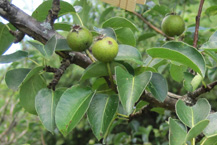
I planted some ripe fruit to see if I can grow rootstock to graft. Also plan to graft onto the tree and start pruning it. BUT, after the record warm Nov into Dec, then sudden drop in mid Dec to zero temps, I noticed bark peeling off all over tree. Is this normal? Sort of looks like the american plum which does similar. Or is it massive bark splits from sudden temp drop? I hope the former and that it is just shedding outer bark, but is really OK. The trunk is covered with sapsucker holes. 1979 - 20151978? 1979? Rootstock from Bartlett pear that died in 1980-82. from Midland nursery. I assume it is common pear seedling, or it could be a commercial OhF rootstock. Grew into a beautiful, large tree. In 2002 or so we noticed some blossoms (likely have had some before). It fruited small, hard VERY bitter little pears. Medsger’s "Edible Wild Plants" lists a "choke pear (pyrus communis) that seemed to fit it so that's what we called it. It has continued to bloom prolifically most years, a great pollinator for our regular pears, since we’ve had some fruit on Stacey and Summercrisp. Didn’t do anything to the tree except admire it until 2016. Copyright © Susan Robishaw |
||
